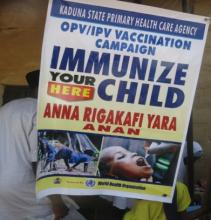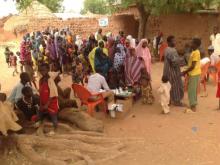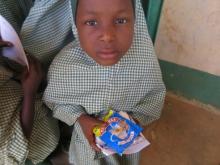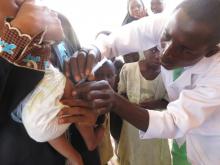Throwing everything at the polio virus: Nigeria combines antigens to stop polio transmission once and for all
Abuja, 19 May 2015 - Nigeria has made significant progress towards the interruption of polio viruses with no confirmed case in 2015 and nine months have elapsed since the last case of wild poliovirus (WPV) was confirmed. Similarly, the latest confirmed circulating vaccine derived polio virus (cVDPV) was isolated six months ago.
However, this gain is threatened by cVDPV in the environment of Kamacha River in Zaria of Kaduna state in March 2015 and in Sokoto South Local Government Area (LGA) in Sokoto state in 2014.
The gold standard for polio surveillance in the Global Polio Eradication Initiative (GPEI) Programme is the detection of cases of acute flaccid paralysis (AFP) and laboratory testing of stool specimens from these patients in a World Health Organization (WHO) accredited laboratory. Environmental surveillance, on the other hand, is complementary to AFP surveillance as it can also detect circulation of wild and vaccine-derived polioviruses in the environment.
Therefore, for Sokoto and Kaduna, an augmented response to the persistent isolation of the environmental cVDPV, was mounted from 25 April to 8 May 2015, targeting all children 0 – 59 months with trivalent oral polio vaccine (tOPV) and a subset of 3 – 59 months children concurrently administered with inactivated polio vaccine (IPV) to boost population immunity in vulnerable LGAs (Wamakko, Sokoto South and Sokoto North LGAs in Sokoto State and Sabongari and Zaria LGAs in Kaduna State) during the just concluded National Immunization Plus Days (NIPDs) exercise.
“I brought my child to the health camp to receive polio immunization when people scared me with the information that polio was isolated from the Kamacha river. I am so happy to have my child immunized. We are grateful to the government for quick intervention in bringing these vaccines quickly to prevent human infection that could lead to paralysis,” said Malama Maryam Usman of Tukur Tukur ward in Zaria LGA of Kaduna.
Creating demand for IPV/OPV
While the combination of the vaccines is to enhance improvement in population immunity as well as prepare for the GPEI End Game Plan for the global switch from tOPV to IPV in 2016, an integrated delivery of services in health camps was adopted to enhance demand. The health camps strategy which address societal health needs, through provision of free services for other health interventions and treatment of minor ailments, have the potential for improving uptake of IPV/OPV from lessons learnt in Borno, Yobe and Kano where such combination was already implemented in 2014.
A total of 683 and 411 health camp sites were established in Kaduna and Sokoto respectively. In line with the guideline of “No child travels a distance of > 0.5Km” to access health camps services, camps were within 500 metre radius for easy access of immunization services across the five LGAs with special attention and positioning of teams along the famous Kamacha bridge and the high risk settlements throughout the implementation period where children suspected to have been shedding the poliovirus in the environment were immunized at different locations.
The WHO Zonal Coordinator who oversees both states, Dr Abdullahi Suleiman, mentioned that “different interventions were offered at the health camps aside the IPV and OPV. Attractive ‘pluses’ such as sugar and milk satchets were given to all children vaccinated with IPV and OPV. In addition, clients that presented with minor ailments were treated at the health camps which further attracted more mothers and children”. The pluses were provided with generous support from the Dangote Foundation as well as Bill and Melinda Gates Foundation.
Combined effort and continued mobilization
Collective efforts by the traditional and religious leaders, WHO, UNICEF and partners assisted in improving community sensitization, mobilization, supporting behaviour change and training health workers to practice safe injection practices and administer potent vaccines.
The Salanken Zazzau, a senior title holder in Zaria emirate and a medical practitioner who monitored the exercise noted that “the combination of IPV and OPV this round will certainly boost immunity among the populace in the communities living along the Kamacha river that has been the source of the environmental cVDPV and we are confident that after this round, polio will be a disease of the past”.
Outcome of the campaign
In Kaduna State, the combined campaign was a success as out of the targeted 361 292 children for OPV, 395 653 (109.8%) were immunized while 341 577(98.9%) children were immunized with IPV against the target of 345 227. Post campaign evaluation from both LGAs in Kaduna which completed the campaign earlier than Sokoto revealed that out of the sampled 60 children by lot quality assurance sampling (LQAS), no child was found missed in Zaria LGA while only two were missed in Sabongari- LGA. The LQAS findings estimate that both LGAs were accepted for at least 90% coverage based on the LQAS.
Meanwhile, in Sokoto, of the 226 806 children 3 – 59 months targeted for IPV, 225 506(99%) were immunized while for OPV, 238 743 children were targeted and 257 063(108%) were immunized. For LQAS, Sokoto North and South LGAs were accepted were accepted at 90% but Wammako is rejected at 80% coverage.
Coverages above 100% were expected as mothers brought children outside the targeted LGAs (from bordering neighbouring LGAs) to benefit from this campaign. Extra IPV had to be quickly mobilized from other LGAs within the states and even extra 30 000 IPV doses delivered from the National Vaccine Cold Store to meet the rising demand.
Continuing efforts to be removed from polio endemic list
It is important to note that in addition to using IPV+ tOPV in campaigns, Nigeria’s unprecedented efforts to interrupt transmission once and for all, and determination to be removed from the “notorious” polio endemic list, led to Nigeria being among the first three countries in Africa in February 2015 to add IPV to the routine immunization schedule, which already provided tOPV to rapidly boost population immunity and to be in line with the global switch from tOPV to bOPV for routine immunization in 2016.
Eradicating polio from the only polio endemic and most populous country in Africa will make an enormous contribution not only to Nigeria’s social and economic advancement but also to the African region and the world as a whole.
_____________________________________
For more information, please contact:
Technical contacts:
Dr Pascal Mkanda; Tel: +234 803 402 2140; Email: mkandap [at] who.int
Dr Suleiman Abdullahi; Tel: +234 803 701 6551; Email: abdullahis [at] who.int
Media contact:
Ms Charity Warigon; Tel: +234 810 221 0093; Email: warigonc [at] who.int
_____________________________________
Below:
01. IPV vaccination in Zaria
02. Health camp banner
03. Women queue up at Sokoto health camp
04. A pupil with her sugar and milk pluses







